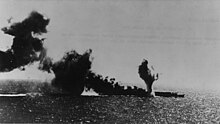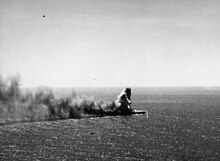Shōhō
|
The Shōhō in 1941
|
||||||||||||||||||
|
||||||||||||||||||
|
||||||||||||||||||
|
||||||||||||||||||
|
||||||||||||||||||
|
||||||||||||||||||
The Shōhō ( Japanese 祥 鳳 , dt. "Very promising Feng ") was a light aircraft carrier of the Imperial Japanese Navy . With its sinking in May 1942, it was the first Japanese aircraft carrier to be sunk in the Pacific War .
construction
It was in 1934 as a submarine -Versorgungsschiff called Tsurugisaki ( 剣埼 ) placed on Kiel and completed 1939th It was also used as such for two years. In 1941 they began to be converted into a light aircraft carrier, which was easily possible due to their design, which allowed them to be completed as a supply ship, oil tanker or aircraft carrier, and their name was changed to Shōhō .
history
Pacific War
During the Second World War she was assigned to the 4th Carrier Division on November 30, 1941 under the command of Kaigun-Taisa Izawa Ishinosuke. She made a few trips to Rabaul to transport planes there.
Port Moresby
In April 1942 she took part with the heavy cruisers Aoba , Kinugasa , Furutaka and Kako of the 6th Cruiser Division under the command of Rear Admiral Gotō Aritomo in Operation MO to capture Port Moresby in New Guinea .
Coral sea and sinking
The Shōhō had secured the landing of Japanese troops on Tulagi on May 3, 1942 and then ran north to escort the Japanese landing fleet that was to attack Port Moresby . Two Japanese fleet carriers were also assigned to the association as remote security. The ensuing encounter with two American fleet carriers resulted in a series of skirmishes that came to be known as the Battle of the Coral Sea , the first naval battle between aircraft carriers.
Japanese reconnaissance planes discovered the carriers USS Lexington and USS Yorktown , but lost them again. When the enemy carriers were reported again on May 7 at 7:22 a.m., the Japanese fleet carriers Shōkaku and Zuikaku started their machines to eliminate this threat to the landing fleet. In the target area, the pilots noticed that their own scout had accidentally identified the tanker USS Neosho and an accompanying destroyer as an aircraft carrier. Both ships were sunk, the American aircraft carriers started their machines almost simultaneously to attack a formation of two aircraft carriers, but they too followed a false report. While the American planes were still approaching, a USAAF scout spotted the Japanese landing force accompanied by the Shōhō near the island of Misima and directed its own carrier aircraft to this new destination.
On May 7, 1942, was Shoho around 11am of 53 Douglas SBD Dauntless- - bombers , and 22 Douglas TBD Devastator- - torpedo planes attacked in several waves. The six fighters used for self-defense were unable to repel the attacks. The anti-aircraft fire from two accompanying Aoba-class cruisers and two Furutaka-class cruisers could not cause any significant damage to the attackers either.
After being hit by at least seven torpedoes and thirteen bombs, the light aircraft carrier sank at 11:35 a.m. 631 crew members were killed. Captain Izawa and 202 men were rescued by the destroyer Sazanami .
The Shōhō was the first Japanese aircraft carrier to be sunk during the Pacific War.
See also
Evidence and references
literature
- John B. Lundstrom: The First Team And the Guadalcanal Campaign. Naval Fighter Combat from August to November 1942. Naval Institute Press, 2005, ISBN 1-59114-472-8 .
- John B. Lundstrom: The First Team. Pacific Naval Air Combat from Pearl Harbor to Midway. Naval Institute Press, 2005, ISBN 978-1-59114-471-7 .
Web links
Individual evidence
- ↑ The Japanese rank Taisa corresponds to the German rank of captain at sea . The prefix Kaigun indicates that it is a naval officer.
- ↑ Joachim Wätzig: The Japanese fleet. From 1868 until today. Brandenburgisches Verlagshaus, Berlin 1996, ISBN 3-89488-104-6 , p. 183
- ^ John B. Lundstrom: The First Team And the Guadalcanal Campaign. Naval Fighter Combat from August to November 1942. p. 3.
- ^ John B. Lundstrom: The First Team. Pacific Naval Air Combat from Pearl Harbor to Midway. P. 197 and following.


